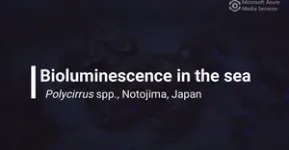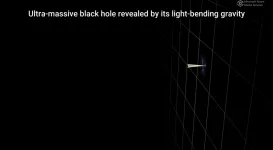Success in simple creation of artificial metalloenzymes with high stereoselectivity
Opens mechanistic study of natural enzymes
2023-03-29
(Press-News.org)
Enzymes work in the cells of all living organisms, allowing specific and complex reactions to be carried out quite easily. However, few natural enzymes are effective for industrial applications, which could benefit greatly from discoveries that make targeted enzyme creation a reality.
Artificial metalloenzymes can be created simply by binding metal ions or metallic compounds to proteins, so that they exhibit enzymatic activity. Currently, metalloenzymes are being studied to discover new functions or improve their reactivity when compared to natural enzymes. Nevertheless, the reaction mechanisms of metalloenzymes are still largely unknown, making it very difficult to design artificial enzymes for specific functions or improved efficiency.
A research group led by Professor Nobutaka Fujieda, Graduate School of Agriculture, Osaka Metropolitan University, has been creating artificial metalloenzymes using small heat-resistant metal-binding proteins. In their latest study, they describe an artificial metalloenzyme they created simply, making use of the 2-his-1-carboxylate metal-binding motif, which is commonly found naturally in non-heme metalloenzymes.
Their new artificial metalloenzyme has a metal-binding site composed of four amino acids, which originally were histidines. The research group mutated these amino acids to create a library of 12 slightly different proteins to compare. After screening the library, they found that the enzyme variant H52A/H58E, when bound with a copper ion, had the best stereoselectivity, so that it reacts selectively with the correct version of the target molecule.
The research group then performed X-ray crystallographic analysis of the metal-binding site, confirming two electron densities derived from the copper ions. Furthermore, docking simulations of two copper ions found that the copper, which protruded slightly, could bind to the substrate. Leading the group to believe that selectivity was maximized by the movement of the copper ion to where the substrate was most likely to bind.
"Such positional transitions of metal ions have also been observed in natural enzymes, so we believe that detailed analysis of our artificial metalloenzyme’s reaction mechanism will deepen what we know about natural enzymes. We hope that the advances of this research will lead to the creation of biocatalysts that can work under mild conditions," Professor Fujieda concluded.
The research results were published in Chemical Science on March 13, 2023.
###
About OMU
Osaka Metropolitan University is a new public university established in April 2022, formed by merger between Osaka City University and Osaka Prefecture University. For more research news visit https://www.omu.ac.jp/en/ or follow @OsakaMetUniv_en and #OMUScience.
END
[Attachments] See images for this press release:


ELSE PRESS RELEASES FROM THIS DATE:
2023-03-29
Lizards may be small, with only a single hearing bonelet compared to our three, and without earflaps, but their hearing is typically good. Most lizards can hear frequencies between 100 and 5,000 Hz (although they are most sensitive between 400 and 1,500 Hz), compared to between 20 and 20,000 Hz in humans. So how do lizards react to noise pollution?
Here, scientists studied the impact of noise from low-flying military aircraft on the behavior and well-being of an uncommon lizard, the Colorado checkered whiptail (Aspidoscelis neotesselatus). This ...
2023-03-29
A research group including Professors Mitsumasa Koyanagi and Akihisa Terakita of the Osaka Metropolitan University Graduate School of Science has investigated both the genetic information and structure of the photoreceptor rhodopsin, responsible for detecting dim light, of whale sharks to investigate how they can see in the dim light at extreme depths. The research group compared the whale sharks to zebra sharks, which are considered their closest relative, and brown-banded bamboo sharks, which are in the same group: the order orectolobiformes—commonly known as carpet sharks.
“This research used genetic ...
2023-03-29
In his new book Primary Health Care and Population Mortality, released next week, Professor Richard Baker draws on international evidence to show how primary health care is key to the effect of health systems on population mortality and inequality in mortality. His conclusion is that it is time to think about primary health care in a new way.
He explains: “It is as if policymakers think primary health care is little more than a triage mechanism for the health system, that its purpose is to manage access to other ...
2023-03-29
A team of astronomers has discovered one of the biggest black holes ever found, taking advantage of a phenomenon called gravitational lensing.
The team, led by Durham University, UK, used gravitational lensing - where a foreground galaxy bends the light from a more distant object and magnifies it – and supercomputer simulations on the DiRAC HPC facility, which enabled the team to closely examine how light is bent by a black hole inside a galaxy hundreds of millions of light years from Earth.
They found an ultramassive black hole, an object over 30 billion times the ...
2023-03-29
Researchers from the Okinawa Institute of Science and Technology (OIST) have developed a method to measure coral biodiversity through extracting the environmental DNA (or eDNA) from a liter of surface seawater collected from above a reef. The method has been confirmed to work through observations made by scientific divers in the same areas of ocean. The research, conducted in collaboration with the Okinawa Prefecture Environmental Science Center and University of Tokyo, was published in the Proceedings of the Royal Society B: Biological Sciences. This has paved the way for large-scale comprehensive surveys of reef-building coral to take place and removes the reliance of ...
2023-03-29
Scientists have found out how some skin cancers stop responding to treatment at the end of life.
An in-depth analysis of 14 patients who died from incurable melanoma has revealed that changes to the order, structure and number of copies of tumour DNA could cause some skin cancers to resist treatment. These changes also explain how melanoma can spread to other parts of the body.
The research, published today (29th March) in the journal Cancer Discovery, was led by scientists and clinicians at the Francis Crick Institute, UCL and The Royal Marsden. It is part of the Cancer ...
2023-03-29
Researchers found that, despite being heavily immunocompromised, haematology patients generate strong cellular immune responses against SARS-CoV-2 after vaccination, on par with that of healthy individuals.
Published today in Cell Reports Medicine, the research team, led by University of Melbourne Professor Katherine Kedzierska, a Laboratory Head at the Peter Doherty Institute for Infection and Immunity (Doherty Institute), undertook the most comprehensive analysis of adaptive SARS-CoV-2 immunity to ...
2023-03-29
The electric vehicle market has been experiencing explosive growth, with global sales surpassing $1 trillion (approx. KRW 1,283 trillion) in 2022 and domestic sales exceeding 108,000 units. Inevitably, demand is growing for high-capacity batteries that can extend EV driving range. Recently, a joint team of researchers from POSTECH and Sogang University developed a functional polymeric binder for stable, high-capacity anode material that could increase the current EV range at least 10-fold.
A research team led by POSTECH professors Soojin Park (Department of Chemistry) and Youn Soo Kim (Department ...
2023-03-29
Kyoto, Japan -- Lead author Yurii Victorovich Kovtun, despite being forced to evacuate the Kharkiv Institute of Physics and Technology amid the current Russia-Ukraine war, has continued to work with Kyoto University to create stable plasmas using microwaves.
Getting plasma just right is one of the hurdles to harnessing the massive amounts of energy promised by nuclear fusion.
Plasmas -- soups of ions and electrons -- must be held at the right density, temperature, and duration for atomic nuclei to fuse together to achieve the desired release of energy.
One recipe involves the use of large, donut-shaped devices with powerful magnets ...
2023-03-29
The opening day of the World Conference of Science Journalists (WCSJ) 2023 in Medellín, Colombia saw hundreds of journalists from 62 countries come together in the stunning setting of the city’s Jardin Botanico.
Over 500 attendees will gather over three days to discuss science journalism, to challenge ideas and to reinforce their professional networks and friendships.
The day began with a keynote on biodiversity delivered by Brigitte Baptiste, a Colombian biologist and expert in biodiversity issues. And it closed with an opening ceremony and vibrant social event for attendees.
Both took place under open skies in the ...
LAST 30 PRESS RELEASES:
[Press-News.org] Success in simple creation of artificial metalloenzymes with high stereoselectivity
Opens mechanistic study of natural enzymes








